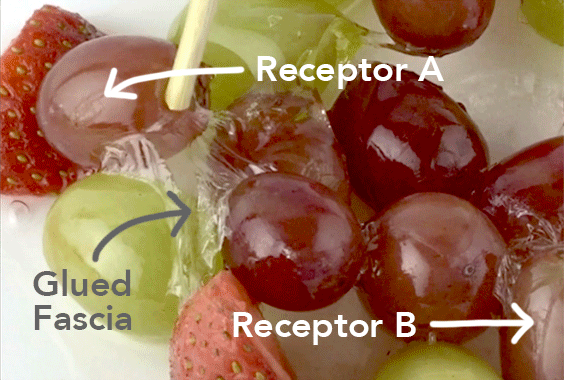In our previous post we explained that proprioception is the sense of position, posture and motion.
This sensory information is key to perform any motor activity, as it gives constant feedback to fine-tune the movements.
We talked about the receptors (mechanoreceptors) and we described them as switches that need to be deformed (stretched, pressed, moved) in order for them to send the signals. Today we know that about 80% of these receptors are in the fascial system.
If we use the example of our jello as the fascia, the fruits in this case are the receptors. If the jello is properly built (it has the right tension/compression), then the receptors are stable and they can accurately sense any deformation.
As your child’s fascia is probably collapsed and/or glued, the switches could sense changes that are happening far from them and they would send the signal anyways.

The receptor B, will send a signal due to the stimuli that it gets from receptor A, as the glued fascia transfers the movement.
Can you imagine the confusion this can cause to the feedback mechanism your child needs to coordinate the movement?
The brain senses something is happening to “B” and sends some activity to regulate it, when in reality it is “A” the one that needs it.
When the fascial system is collapsed, the receptors that help create a map of the body in the brain are confused, so it is harder for the brain to understand what is happening in the rest of the body.
These research papers refer to this topic.
WeFlow´s tip for you!
Deep but gentle pressure is a great way to create awareness of one specific body part. You can put floaties on your child’s feet and send more signals of the feet to the brain.
We send weekly ideas like this via email. If you want to receive them, subscribe here
—————
Fascia y propiocepción - Parte 2
En nuestra entrada anterior explicamos que la propiocepción es el sentido de la posición, la postura y el movimiento.
Esta información sensorial es clave para poder realizar cualquier actividad motora, ya que provee un feedback constante para ajustar los movimientos.
Hemos hablado acerca de los receptores (mecano-receptores) y los describimos como suiches que deben ser deformado (estirados, presionados, movidos) para que puedan enviar la señal. Hoy sabemos que el 80% de estos receptores están en el sistema fascial.
Si usamos el ejemplo de nuestra gelatina como la fascia, las frutas en este caso son los receptores. Si la gelatina está adecuadamente formada (tiene la tensión/compresión correcta), entonces los receptores están estables y puede de forma precisa sentir cualquier deformación.
Pero como la fascia de sus hijos está probablemente colapsada y/o empegostada, los suiches pueden sentir cambios que están sucediendo lejos de ellos, y van a enviar la señal de todas maneras.

El receptor B envía una señal por el estímulo que recibe del receptor A, ya que la fascia empegostada transfiere el movimiento.
¿Puedes imaginar la confusión que esto puede causarle al mecanismo de retroalimentación que tu hijo(a) necesita para coordinar el movimiento?
El cerebro siente que algo está pasando en “B” y envía una actividad para regularlo, cuando la realidad es que es “A” el que lo necesita.
Cuando el sistema fascial está colapsado, los receptores que ayudan a crear el mapa del cuerpo en el cerebro están confundidos, lo que le dificulta al cerebro entender lo que sucede con el resto del cuerpo.
¡Tips de WeFlow para ti!
Hacer presión suave es una gran manera de incrementar la percepción de un área específica del cuerpo. Puedes colocar flotadores en los pies de tu hijo(a) para enviar más señales desde los pies al cerebro.
